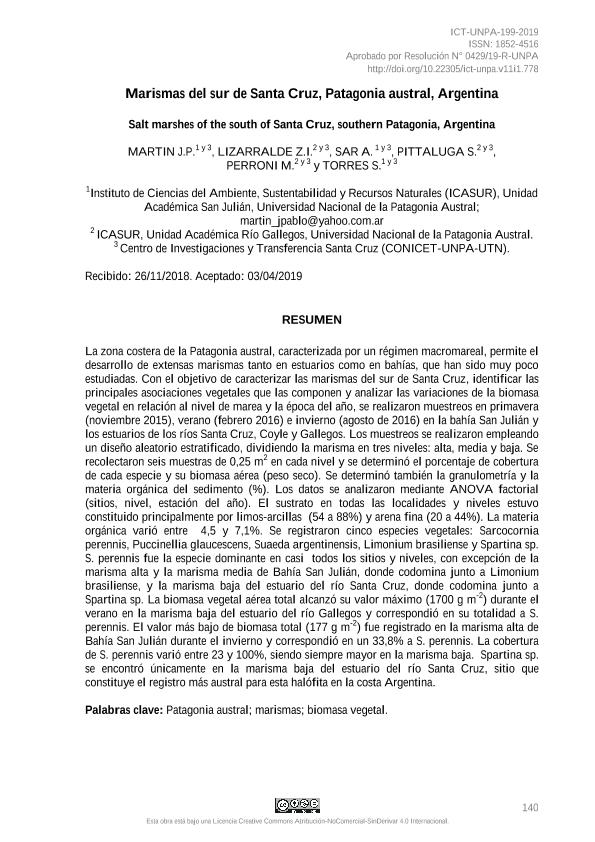Artículo
La zona costera de la Patagonia austral, caracterizada por un régimen macromareal, permite el desarrollo de extensas marismas tanto en estuarios como en bahías, que han sido muy poco estudiadas. Con el objetivo de caracterizar las marismas del sur de Santa Cruz, identificar las principales asociaciones vegetales que las componen y analizar las variaciones de la biomasa vegetal en relación al nivel de marea y la época del año, se realizaron muestreos en primavera (noviembre 2015), verano (febrero 2016) e invierno (agosto de 2016) en la bahía San Julián y los estuarios de los ríos Santa Cruz, Coyle y Gallegos. Los muestreos se realizaron empleando un diseño aleatorio estratificado, dividiendo la marisma en tres niveles: alta, media y baja. Se recolectaron seis muestras de 0,25 m2 en cada nivel y se determinó el porcentaje de cobertura de cada especie y su biomasa aérea (peso seco). Se determinó también la granulometría y la materia orgánica del sedimento (%). Los datos se analizaron mediante ANOVA factorial (sitios, nivel, estación del año). El sustrato en todas las localidades y niveles estuvo constituido principalmente por limos-arcillas (54 a 88%) y arena fina (20 a 44%). La materia orgánica varió entre 4,5 y 7,1%. Se registraron cinco especies vegetales: Sarcocornia perennis, Puccinellia glaucescens, Suaeda argentinensis, Limonium brasiliense y Spartina sp. S. perennis fue la especie dominante en casi todos los sitios y niveles, con excepción de la marisma alta y la marisma media de Bahía San Julián, donde codomina junto a Limonium brasiliense, y la marisma baja del estuario del río Santa Cruz, donde codomina junto a Spartina sp. La biomasa vegetal aérea total alcanzó su valor máximo (1700 g m-2) durante el verano en la marisma baja del estuario del río Gallegos y correspondió en su totalidad a S. perennis. El valor más bajo de biomasa total (177 g m-2) fue registrado en la marisma alta de Bahía San Julián durante el invierno y correspondió en un 33,8% a S. perennis. La cobertura de S. perennis varió entre 23 y 100%, siendo siempre mayor en la marisma baja. Spartina sp. se encontró únicamente en la marisma baja del estuario del río Santa Cruz, sitio que constituye el registro más austral para esta halófita en la costa Argentina. The coastal zone of southern Patagonia, characterized by a macrotidal regime, allows the development of extensive salt marshes in estuaries and bays, which have been little studied. In order to characterize the marshes of the south of Santa Cruz, identify the main vegetal assemblages and analyze the variations of the vegetal biomass in relation to the tidal level and the time of the year, three samplings were carried out in spring (November 2015), summer (February 2016) and winter (August 2016) in San Julián Bay and the estuaries of the Santa Cruz, Coyle and Gallegos rivers. The samplings were performed using a stratified random design, dividing the salt marsh into three levels: high, middle and low. Six samples of 0.25 m2 were collected at each level, and the percentage of coverage of each species and its aerial biomass (dry weight) was determined. Substrate grain size and organic matter content of the sediment (%) were also determined. The data were analyzed by factorial ANOVA (locality, level, and season of the year). The substrate in all localities and levels consisted mainly of silt-clays (54 to 88%) and fine sand (20 to 44%). Organic matter content varied between 4.5 and 7.1%. Five plant species were recorded: Sarcocornia perennis, Puccinellia glaucescens, Suaeda argentinensis, Limonium brasiliense and Spartina sp. S. perennis was the dominant species in almost all localities and levels, with the exception of the high and the middle saltmarsh of San Julián Bay, where it codominates with Limonium brasiliense, and the low marsh of the estuary of the Santa Cruz River, where it codominates together with Spartina sp. The total aerial vegetation biomass reached its maximum value (1700 g m-2) during the summer in the low marsh of the estuary of the Gallegos river; all the biomass corresponded to S. perennis. The lowest value of total biomass (177 g m-2) was recorded in the high marsh of San Julián Bay during the winter and corresponded in 33.8% to S. perennis. The coverage of S. perennis varied between 23 and 100%, being always higher in the low marsh. Spartina sp. was found only in the low marsh of the estuary of the Santa Cruz River, site that constitutes the southernmost record for this halophyte on the Argentina coast.
Marismas del sur de Santa Cruz, Patagonia austral, Argentina
Título:
Salt marshes of the south of Santa Cruz, southern Patagonia, Argentina
Martin, Juan Pablo; Lizarralde, Zulma Isabel; Sar, Alicia Manuela; Pittaluga, Teresa Susana; Perroni, Mario Oscar; Torres, Santiago Hernan

Fecha de publicación:
28/05/2019
Editorial:
Universidad Nacional de la Patagonia Austral. Secretaría de Ciencia y Tecnología
Revista:
Revista de Informes Científicos
ISSN:
1852-4516
Idioma:
Español
Tipo de recurso:
Artículo publicado
Clasificación temática:
Resumen
Palabras clave:
PATAGONIA AUSTRAL
,
MARISMAS
,
BIOMASA VEGETAL
Archivos asociados
Licencia
Identificadores
Colecciones
Articulos(SEDE CENTRAL)
Articulos de SEDE CENTRAL
Articulos de SEDE CENTRAL
Citación
Martin, Juan Pablo; Lizarralde, Zulma Isabel; Sar, Alicia Manuela; Pittaluga, Teresa Susana; Perroni, Mario Oscar; et al.; Marismas del sur de Santa Cruz, Patagonia austral, Argentina; Universidad Nacional de la Patagonia Austral. Secretaría de Ciencia y Tecnología; Revista de Informes Científicos; 11; 1; 28-5-2019; 140-153
Compartir
Altmétricas



